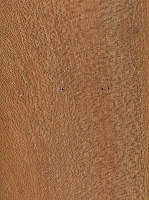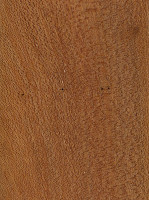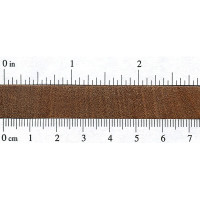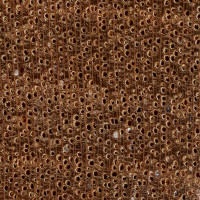 |
Common Name(s): Dark Red Meranti, Lauan, Philippine Mahogany Scientific Name: Shorea spp. Distribution: Southeast Asia Tree Size: 65-130 ft (20-40 m) tall, 3-6 ft (1-2 m) trunk diameter Average Dried Weight: 42 lbs/ft3 (675 kg/m3) Specific Gravity (Basic, 12% MC): .55, .68 Janka Hardness: 800 lbf (3,570 N) Modulus of Rupture: 12,710 lbf/in2 (87.7 MPa) Elastic Modulus: 1,743,000 lbf/in2 (12.02 GPa) Crushing Strength: 7,070 lbf/in2 (48.8 MPa) Shrinkage: Radial: 3.9%, Tangential: 7.8%, Volumetric: 12.5%, T/R Ratio: 2.0 |
Color/Appearance: Typically a dark reddish or purplish brown; commonly with white resin streaks present.
Grain/Texture: Grain can be straight or interlocked. With a coarse texture and low natural luster.
Endgrain: Diffuse-porous; large to very large pores in no specific arrangement, few to very few; solitary and radial multiples of 2-3; tyloses occasionally present; parenchyma vasicentric, winged, and banded with embedded resin canals; narrow to medium rays, spacing normal.
Rot Resistance: Reported as moderately-durable to non-durable in regard to decay resistance, but is susceptible to insect attack.
Workability: Typically easy to work, though any interlocked grain can present problems during planing, and Dark Red Meranti is reported to have very poor steam-bending properties. Some species may have a slight blunting effect on tools due to small levels of silica present in the wood. Glues, stains, and finishes well.
Odor: No characteristic odor.
Allergies/Toxicity: Although severe reactions are quite uncommon, Meranti in the Shorea genus has been reported to cause eye, throat, and skin irritation. See the articles Wood Allergies and Toxicity and Wood Dust Safety for more information.
Pricing/Availability: Meranti is widely harvested and available worldwide. It should be moderately priced despite the fact that it is imported.
Sustainability: Meranti is not listed in the CITES Appendices, but many species in the Shorea genus are on the IUCN Red List. The majority of Shorea species are listed as being critically endangered due to a population reduction of over 80% in the past three generations, caused by a decline in its natural range, and exploitation. Sustainable/certified sources of Meranti are also available.
Common Uses: Plywood, interior furniture, general construction, concrete forms, veneer, and boatbuilding.
Comments: Dark Red Meranti is sometimes referred to as Red Lauan, wood in the Shorea genus is very commonly used in southeast Asia, and there is an abundance of variety between the difference species: each with different working properties, appearances, and mechanical strength values.
Main groupings for Shorea spp. are: Light Red Meranti, Dark Red Meranti, White Meranti, Yellow Meranti, and Balau. The strength and mechanical values listed at the top of this page represent the average of a handful of species within the corresponding group.
Also called Philippine Mahogany, Meranti bears no relation to what is considered to be “true” mahogany in the Swietenia and Khaya genera.
 |
 |
 |
 |





Would you know the growth rate of the Meranti? I can’t seem to find anything anywhere on growth of the Meranti species in general. Thanks in Advance.
What would you recommend for preserving Meranti Hardwood when used as cladding externally?
How can we identify the RED MARANTI is different from other wood?
It’s hard for me to say, I’m not sure what other woods red meranti might be confused with in your location? Can you give me a few examples of other woods that might be mixed up with it? I may be able to give more specific advice if things are narrowed down a bit.
I am from India and The wood I ordered is RED MARANTI and I visually inspected as that Half materials comes in Light Red Color, and half in light White (Cream). so, I want to know the exact Test Name which I can applied on wood to confirm that which one is the RED MARANTI and which one is NORMAL. Will you suggest ANY TEST NAME OR HOW TO DIFFRENTIATE?
Can you ID this wood for me? I’m told “dangai” ..but can find nothing on that name. It seems like meranti..it’s extremely oily…after finishing there’s actually oil that seeps from the face and looks like there’s wet spots. This piece i got was grown in the Philippines.
https://imgur.com/gallery/BQyI7le
Whatever it is, it looks like the pores are very large and open. Have you tried using a blacklight and checking for fluorescence? Based on your location, it could possibly be a species of Albizia or a closely related species. If it is, then it would more than likely glow pretty strongly under a blacklight. https://www.wood-database.com/hardwoods/fabaceae/albizia/
Nope .I sure haven’t held a black light to it .gotta get my hands on one first. I’ve never heard of albizia before though so thanks for the lead. Any other tips are appreciated.
So I bought an incandescent black light bulb at 75 w. Planned a piece down and held it under …and nothing. I held it next to other woods such as walnut just to make sure I know what normal wood looks like. So I’m at a dead end again. What would you suggest I do? The only other thing I can say about it is it secrets a sap I’d call it after planning and even after finishing. Got any tips? Can I send a small piece directly to you possibly so you can possibly ID it first hand. Thank… Read more »
Just to be clear, did you try viewing it with the blacklight in darkness with all other outside lights off? Is there any noticeable scent? Also, can you compare the weight to another known wood?
It was in my basement…completely dark. No scent really that stands out. The weight is like monkey pod..and so is the grain…long grain that isn’t quite uniform. I ordered a different black light. The bulb I tried using I got from the hardware store but doesn’t make anything else glow. I’m no lightbulb genius ..but back when I would party hard around black light my teeth/shirt…and lots of other stuff would glow. When I held this one to my teeth and other items nothing happened . So I bought one off line that is used for detecting urine and such…says… Read more »
Albizia species will pretty consistently fluoresce under a blacklight. If this new light you are getting doesn’t produce a response in the wood, I think it’d be pretty safe to rule out Albizia.
Well…got the light. It’s pretty powerful to say the least and nothing lit up on the wood. I planned a piece down first to give a fresh face and nothing. I DID notice however that the sap that leaks from the grain lit up a pinkish color under the light ..but not the wood itself.
Well, the other wood I was thinking to suggest was Aglaia species, but it has a strong odor, so I don’t think that’s what you’ve got. Being from the Philippines, there’s a chance that it’s just something that I’ve not yet added to the site yet. I do have over 800 species that are still unlisted at the moment, so quite a few to go still. Sorry I can’t be of more help.
vengai wood?
So here’s the deal. No one can ID it for me. I was lucky enough to get accepted from the Oregon State University’s ‘wood forensic laboratory’ to do a free test on it. I sent some in along with a free picture frame made from it as a thank you and wouldn’t you know it, they cannot ID it. They told me they are going to do some more testing but as far as they know it’s unknown. I was going to post an update once they tell me a species or say they have a completely unknown one on… Read more »
So… How is the ID of the wood going Jeremiah?
BALAKAT (Ziziphus talanai) That’s what I found out. I didn’t get the ID from the Oregon lab, they didn’t even know. I eventually got the true name from the importer.
It’s an extremely oily wood. I’ll never use it again. Never seen oil drops extrude from wood like this before. It’s unfortunate because it really is pretty and has some nice chatoyance. Maybe cutting boards I’d use it for? My buddy got a bunch and made a boat dock for someone, being super oily he figured it must be up for the durability test.
Thank you, this guide was very useful in identifying a piece of wood I found.
We are using this material for decking, KD’ed then oil finished. 3 years and it shows no sign of rotting or inscet damage.
I have a load of this wood planks on my garden I bought for a donation of £25 from a charity . I recently decided rather than buying a new worktop in my campervan sand some of these planks and danish oil them . Didn’t know what wood it was buy a local building unit said it is meranti . Long and short of it my campervan looks lovely new worktop . Cost next to nothing apart from lots of sanding . Very very please
I appreciate this publication’s information on how much red meranti weighs (in kg/m3) when it is dry. However, does anyone know how much it weighs per m3 when it is green (ie, freshly cut). Disclaimer: I was required to provide a URL. So I provided the URL of TNC. Until the end of the the 2018 calendar year, I am on a consulting contract to TNC. But I am not an employee, and I am not 100 percent certain that I have authorization to use the organization’s URL (below).
What are your thoughts on using dark red meranti for oars? Anyone ever done this? They’re for a rowboat that’s stored inside, so the oars won’t get much weather.
Cort is using this to build guitars…do you know anything about it’s tone qualities as relates to guitars or musical instruments in general…?
I’m not sure about the use in guitars, but I was given some and have made a couple of large bore Native American Style Flutes in the “A3” Bass range and they turned out beautiful sounding, but did need some major sealing before getting the flutes to where they would make a sound…. it is extremely porous…..and any air leaks will cause a flute to not make a sound. Other that that is worked very well for these flutes and I’m planning on making flutes out of the remaining 2 pieces that were given to me.
Ibanez uses Moranti on most of their low level instruments like the JEM Junior since 2018. But I didn’t play any guitar made of this wood yet, so I cannot say anything about tone quality. I just found this statement:
“Meranti is a low cost timber which is used for it’s strength rather than tonal properties. This allows factories to build low-cost guitars that still work, although the tone will be poor when compared to the woods above.”
https://normans.zendesk.com/hc/en-us/articles/213850143-What-Tonewood-Should-I-choose
Hi
Whats the fire rating for the red meranti wood. the thickness is @140mm
For Fire rating solid wood need minimum density.640 kg/M3
I have some wood that I am using for the body of a bass guitar project. It looks to me like one of the meranti types but it exudes a very sticky resin when it gets warm either through use of power tools or simply left in the moderate sun of an English “summer”. It is a dense, heavy wood. The long grain finishes well and it looks good when oiled. I wonder if it could be keruing (Dipterocarpus) species? Any views on the best way to seal the end grain to prevent the resin damaging the clear laquer finish… Read more »
I made a nice cabinet door out of the common (and cheap) 3/16 inch thick lauan panels that you can get at any hardware store in the USA. It stained well, and it is holding up well. That type of Lauan has two different plies I guess of the stuff… one looks like this dark red meranti (and is characteristic of lauan), while the other panel looks more like a veneer plywood you might think resembles American oak or birch… the main difference is that the veneer side has poorly typed knotholes and unfinished checks that are unsightly. To use… Read more »
hi..
can we use this meranti for pergolas and exterior wood design purposes?
I recently salvaged several hundred feet of dark red meranti from a 60 year old hospital building in Guam. It is 2 inches thick and about 6 inches wide, and beautiful straight grained. We’ve made some very nice projects from the wood, which has a rich dark finish after being rubbed with a Danish oil finish.
I am based in Gandhidham, Gujrat, India.
i have seen so many wood but
in gandhidham there is five type of meranti which is represent different
type of weight, grain and all.
That is Plotter Meranti, Small, Super Small, Regular and commercial meranti as well.
I am a picture framer in Australia and in most cases when building stretchers for canvas I have used farmed pine. I have become aware that Meranti is now available. It is a lot tougher than farm pine but the questions I wanted to ask you are:
If this is available then should I be investigating how it is being sourced? e.g. Is it being farmed, or inappropriately cut down?
Are you able to give me some sort of brief in terms of it quality, relevant to what I do, if it is ethical to use?
Thanks
Royce
Hi, do source for owners of PEFC certified Meranti.
Ho Royce ,I’m Mikels from Mauritius.here we use red meranti for different purposes entrance doors,furniture,construction sites,windows,table,outdoor furniture etc….I think on our page we have same furniture made of….fbk entretien maison express
Dear sir,
I am based in Gandhidham,Gujrat,India.
i have seen so many wood but in gandhidham there is five type of meranti which is represent different type of weight,grain and all.
That is Plotter Meranti,Small,Super Small,Regular and commercial meranti as well.
is drk red mrnti suitable for swimming pool deckings after its has been kiln dried?
I’ve never heard of any type of Meranti growing anywhere in Africa—it seems to be a mostly Asian wood. I could be wrong, but perhaps you are referring to a different wood species?
dear sir i wish to know if merantis are in cameroon’s forest and what are its common name called in cameoon and its scientific name.
Where could we fine them in cameroon .